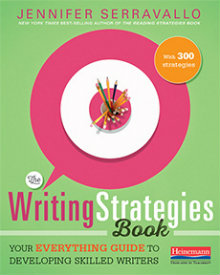Easy-to-Use Strategies to Develop Young Writers
The Writing Strategies Book: Your Everything Guide to Developing Skilled Writers
By Jennifer Serravallo
(Heinemann, 2017 – Learn more)

You know that rushed feeling of being an educator and seeing a resource book that looks really interesting, yet you can’t help but think: When am I ever going to have time to read and digest 400 pages of text when tomorrow is coming up fast and I have to teach lessons to classrooms full of kids?
Don’t let that inner voice stop you from perusing Jennifer Serravallo’s new text, The Writing Strategies Book: Your Everything Guide to Developing Skilled Writers. (Serravallo’s earlier book, The Reading Strategies Book, is also worth a look.)
300 writing strategies and lessons

Flip through the book to find a ton of great ideas — helping students engage more with their own writing process; organizing ideas for short and longer fiction and non-fiction pieces; structuring assignments for all learners, or providing structure for student collaboration opportunities.
While there might be some merit in going through the book in sequence, start to finish, it’s unlikely many teachers will adopt that approach. Serravallo anticipates this and has made it easy for teachers to utilize a handy pick-and-choose option through her various organizational structures, indexes and charts.
Tailor-made for harried teachers
In short, The Writing Strategies Book is tailor-made for the harried teacher. Like me and like you. While the book covers a span of early elementary through middle school, the author always indicates which strategies might work best for which grade, and of course, all the ideas can be adapted for any grade level, as she acknowledges in the introduction.
Serravallo has organized her book around ten “goals” of writers, including:
- Composing with Pictures
- Engagement: Independence, Increasing Volume and Developing a Writing Identity
- Generating and Collecting Ideas
- Focus and Meaning
- Organization and Structure
- Elaboration
- Word Choice
- Conventions: Spelling
- Conventions: Grammar and Punctuation
- Collaborating with Writing Partners and Clubs
After spending time with her sections on Engagement, Organization, and Elaboration I came away with at least a half dozen ideas I plan to try out with my sixth graders.
Some strategies I plan to try out
► Experiment with Change, an engagement strategy, encourages students to find that spot in a draft piece of writing that just isn’t coming together. The lesson involves the student literally covering up the section of text (Serravallo suggests strip paper but it could be done any number of ways) and writing something new, then comparing the results. This allows the writer to take a chance on something different in plot or style while not losing the original content.
► In Audience for Information, Serravallo has students thinking about audiences for an informational text and considering through various brainstorming methods what the best format would be for which kind of reader. How would a poster be different from a blog post? Or how might a graphic require a different writing approach than a report? This is part of her work around organizing writing for structure.
► In Tell What It’s Not (To Say What It Is), the lesson (#239) has students practice writing details without ever explicitly mentioning the place or person or idea that is being discussed, as part of an elaboration strategy.
And there are 297 other strategies to pull from, too, all guided by Serravallo’s knowing voice and put into meaningful context before each presentation of ideas. The Writing Strategies Book lives up to its billing: It is what it says it is – a rich resource of writing ideas that could be used in your classroom, tomorrow morning.
Kevin Hodgson is a sixth grade teacher in Southampton, Massachusetts, and is the outreach co-director with the Western Massachusetts Writing Project. Kevin blogs regularly at Kevin’s Meandering Mind and tweets more often than is healthy under his @dogtrax handle.


































